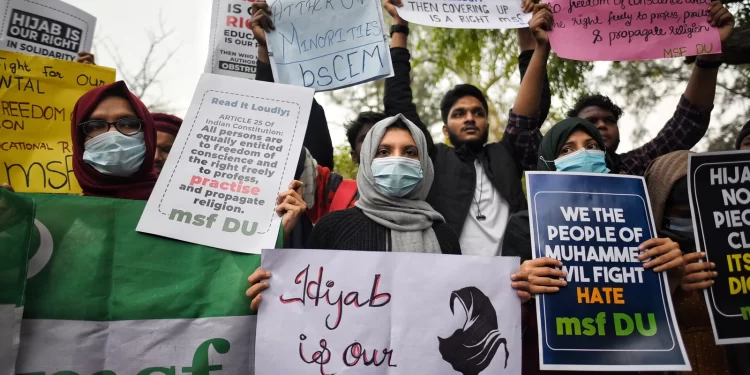On September 16 in 2022, Mahsa Amini died of her wounds in a hospital after being detained by the Iranian morality police for ‘improperly wearing the hijab’. Rumor has it that she was beaten during her arrest, a fact which led to wide protests across the globe.
One year later, a new dramatic event shook Iran: a 16-year-old girl was found unconscious with a head wound in a Tehran subway train. Her name is Armita Geravand and she is currently in a coma in critical condition.
The question remains as to what happened to Geravand after she entered the train seconds before she was attacked. Video surveillance footage released by the authorities shows Armita Geravand, who was not wearing a hijab, approaching a stationary subway train at Meydan-E Shohada station, accompanied by two other girls. The trio enter the train, then one of the girls suddenly recoils before several passengers pull the unconscious girl from the carriage.
Multiples versions of the incident
Two main versions of the event quickly started to spread.
Since Monday, the public media and the Tehran Metro Authority have been claiming that the teen fainted and hit her head on the entrance of the metro carriage as she fell. This version was also supported by one of her friends during her appearance on Iranian state television. Her parents also appeared in state media footage claiming a blood pressure issue, a fall, or perhaps both contributed to their daughter’s injury.
On the other hand, several Iranian human rights groups and activists, along with at least two witnesses interviewed by the British daily ‘The Guardian’ claimed that she was pushed by a morality police officer. They demand an independent investigation by the United Nations’ fact-finding mission on Iran, citing the use of pressure on victims’ families and state TV’s history of airing hundreds of coerced confessions.
According to Hengaw, a Norwegian-based advocacy group for the rights of Iranian Kurds, she was “beaten” by female members of the morality police responsible for enforcing compulsory hijab. The advocacy group also claimed that security forces arrested Geravand’s mother, Shahin Ahmadi, after the incident.
The opposition media Radio Farda, using a source at the hospital, reported the presence of security forces since Geravand’s admission, “especially in intensive care”. A journalist for Shargh newspaper who went to the hospital was arrested, casting more doubt on the government’s version of the incident.
No video footage of the interior of the train has been released, even though most Tehran metro carriages are equipped with surveillance cameras. “The refusal to publish the images only increases doubts about the official version,” stresses the Oslo-based NGO Iran Human Rights.
After what happened to the teen, international reactions were swift.
US Deputy Special Envoy for Iran Abram Paley wrote that he was “shocked and concerned about reports that Iran’s so-called morality police had assaulted 16-year-old Armita Geravand.” While German Foreign Minister Annalena Baerbock called it “intolerable” that a young woman “is once again fighting for her life for not wearing a hijab”.
Iranian authorities likely worry about this incident escalating into popular anger, as happened in Amini’s case. Women continue to ignore the hijab law despite the growing crackdown; since the large-scale protest subsided, many women can be seen without a hijab in the streets.
Tehran’s city government hired some 400 people as “hijab guards” to give verbal warnings, prevent uncovered women from entering subway cars, and hand them over to police.
The hijab in Iran: a subject of controversy in recent times
The 1979 Iranian Revolution led to the replacement of the Imperial State of Iran to the present-day Islamic republic of Iran. For women, since 1981, it means the covering of hair with a hijab is mandatory.
Under Iranian law, which is based on the country’s interpretation of Sharia – in Arabic the “clear, well-trodden path to water”, meaning Sharia acts as a code for living that all Muslims should adhere to, women and girls above the age of puberty must cover their hair with a hijab and wear long, loose-fitting clothing to disguise their figures.
In September, a new bill was introduced in Iran, one which aims to increase prison terms and fines for women and girls who break the strict dress code. Members of parliament voted by 152 to 34 to pass this “Hijab and Chastity Bill”, which says people who are caught dressed “inappropriately” in public places will be subject to a “fourth degree” punishment. According to the penal code, that means a prison sentence of between five and ten years and a fine of between 180m and 360m rials ($3,651-$7,302).
Eight independent UN human rights experts warned the bill “could be described as a form of gender apartheid, as authorities appear to be governing through systemic discrimination with the intention of suppressing women and girls into total submission”.
But since the death of Masha Amini, the hijab also became a political symbol of rebellion against the regime. While the refusal to wear hijabs in Iran largely displeases the Iranian government, some women have decided to risk the consequences of their rebellion and continue to defy the country’s strict laws.
By Léa Montagne














